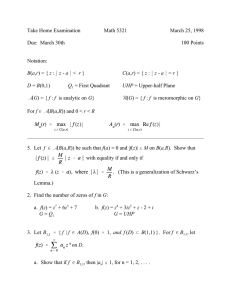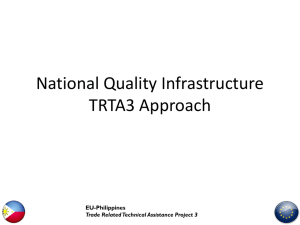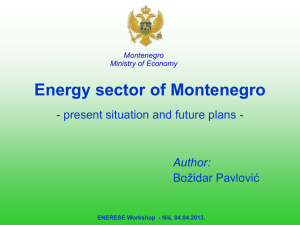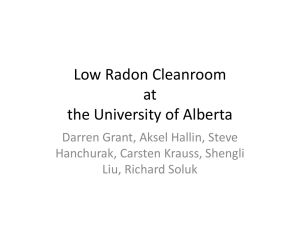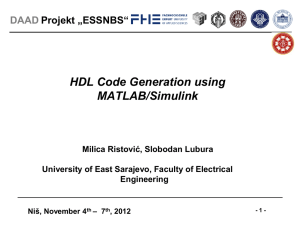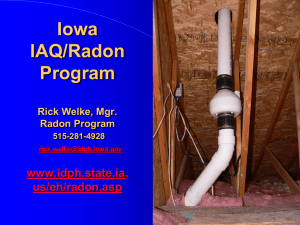The Serbian radon mapping project: overview, status
advertisement
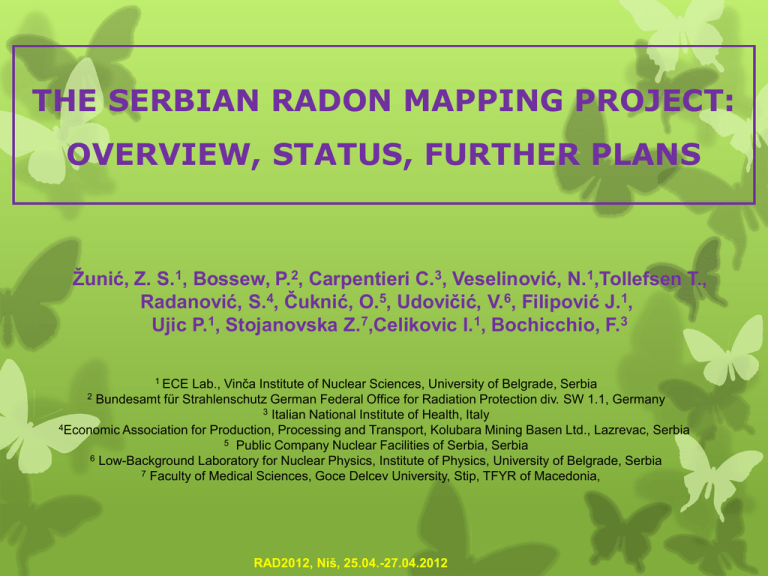
THE SERBIAN RADON MAPPING PROJECT: OVERVIEW, STATUS, FURTHER PLANS Žunić, Z. S.1, Bossew, P.2, Carpentieri C.3, Veselinović, N.1,Tollefsen T., Radanović, S.4, Čuknić, O.5, Udovičić, V.6, Filipović J.1, Ujic P.1, Stojanovska Z.7,Celikovic I.1, Bochicchio, F.3 1 ECE Lab., Vinča Institute of Nuclear Sciences, University of Belgrade, Serbia Bundesamt für Strahlenschutz German Federal Office for Radiation Protection div. SW 1.1, Germany 3 Italian National Institute of Health, Italy 4Economic Association for Production, Processing and Transport, Kolubara Mining Basen Ltd., Lazrevac, Serbia 5 Public Company Nuclear Facilities of Serbia, Serbia 6 Low-Background Laboratory for Nuclear Physics, Institute of Physics, University of Belgrade, Serbia 7 Faculty of Medical Sciences, Goce Delcev University, Stip, TFYR of Macedonia, 2 RAD2012, Niš, 25.04.-27.04.2012 Beginning of the study Radon project objectivites: •Determination of national geographical distribution of indoor radon •Corelation with geology and building characteristic •Identification/prediction of high exposure situations •Development of appropriate remedial/preventative measures •To improve public perception of environmental radioactivity RAD2012, Niš, 25.04.-27.04.2012 Periods of investigation: Period I-HOUSES: Overview 1997-2008 1.1997-1999 (Kalna (Rn),Gornja Stubla (Rn & Tn), Adriatric Coast (Rn); Montenegro 2.2003-2007 (Bujanovac, Zlatibor, Han Pijesak, Hydrometereological stations, Niska Banja, Obrenovac (Rn & Tn) Period II-HOUSES AND SCHOOLS: Overview 2007-2011 1.2007-2011 (Houses of North Kosovo, Central Kosovo and Prizren region (Rn & Tn)) 2.2008-2010 (Schools in Pčinjski district, Jablanički district and Zaječarski district (Rn & Tn)) Period III-HOUSES: Current status and further plans 2009-2012 1.2011-2012 Current project - Houses of Sokobanja (Rn & Tn, Rn/Tn progeny), ONION model 2.2009-2012 Houses of Kosovo 3.Integration of Serbian data into the European indoor Radon map RAD2012, Niš, 25.04.-27.04.2012 ECE history ECE Lab, transfered from NIRS (Chiba, Japan) and founded at Vinca Institute, March 17, 2003 II ECE workshop, I ECE workshop, ’’The new perspectives for thoron ’’Promotion of ECE Lab’’, survey and dosimetry’’, 2003, Belgrade 2005, Niška Banja, South Serbia RAD2012, Niš, 25.04.-27.04.2012 IV ECE workshop ’’Status of work related to radon in Serbia: ongoing projects, international collaboration and plans’’, 2011, Kragujevac, Central Serbia III ECE workshop ’’First Results of the Serbian Radon (Risk Mapping) Survey ’’, 2010, Beograd and Sokobanja RAD2012, Niš, 25.04.-27.04.2012 DETECTORS Type of detector Radionuclide Origin Used in period: UFO Rn/Tn Chiba, Japan •1998.-1999. •2003. - 2007. RADUET Rn/Tn Chiba, Japan •2005.-2012. CR-39 ISS Rn ISS, Italy •2008.-2012. Rn/Tn progeny Rn/Tn progeny BABHA Center, India •2010.-2012. UFO Rn/Tn progeny RAD2012, Niš, 25.04.-27.04.2012 RADUET CR-39 Period I: 1997-2003-2007 Nine field locations: (Rn or Rn&Tn) with Number of houses Field site Radionuclide Number of houses Kalna Rn 75 Montenegro Adriatic Coast Rn 78 Gornja Stubla Rn&Tn 65 Bujanovac Rn&Tn 16 Zlatibor Rn&Tn 12 Han Pjesak Rn&Tn 39 Hydro Meteorological Station (HMS) Rn&Tn 24 Niška Banja Rn&Tn 65 Obrenovac (TENTB) Rn&Tn 19 Total 393 RAD2012, Niš, 25.04.-27.04.2012 Investigated areas since 1997 to 1999 (Rn) RAD2012, Niš, 25.04.-27.04.2012 High Thoron and High Radon: Gornja Stubla (Kosovo) RAD2012, Niš, 25.04.-27.04.2012 Investigated areas since 1997 to 2007 (Rn&Tn) Radon effective equvalent doses in investigated rural Balkan communities Han Pijesak EED Radon (mSv yr - HMS 60 Bujanovac 50 Zlatibor TENT B Eff. Equ. Dose 1 ) 40 Niška Banja 30 Gornja Stubla 20 10 0 MIN AR. MEAN Concentration MAX (Bq m -3) RAD2012, Niš, 25.04.-27.04.2012 Investigated areas since 1997 to 2007 (Rn&Tn) Thoron effective equvalent doses in investigated rural Balkan communities Han Pijesak EED Thoron Eff. Equ. Dose. (mSv yr -1) HMS Bujanovac 35 30 25 20 15 10 5 0 Zlatibor TENT B Niška Banja Gornja Stubla MIN AR. MEAN Concentration (Bq m -3) RAD2012, Niš, 25.04.-27.04.2012 MAX Radon issue in schools of Serbia – the activities from May 2008 to 2011- ORGANIZATION CONTACTS CONTRACTS FIELD ACTIVITY FIELD WORK REPORTS DETECTORS DELIVERY LABORATORY WORK RESULTS MAPPING RAD2012, Niš, 25.04.-27.04.2012 Preparation before field work in schools II Administrative implementation I Design implementation •Contact with municipality: Rn survey performed in exchange for logistic support Logistical implementation III Logistical implementation •Visiting of the area, deployment/collection of detectors, informing local authorities about progress RAD2012, Niš, 25.04.-27.04.2012 •Select schools; In schools: select room; In room: select location. Communicate to teachers: purpose, method, how to treat the detectors, etc. RAD2012, Niš, 25.04.-27.04.2012 Field work in schools Protocol and database Each site is represented by a file consisting of protocol (one for each visit) and data sheet. The protocol includes for following data: • Site: district, municipality, village, name of school; • GPS coordinates (map if aveilable) • Type of room, floor level, location of detector in the room; • Date of detector deployment or collection; • Detector codes; • (observations, remarks). Information on school and municipality: • School: construction year, construction type (building material), photo; • School: number of pupils and teachers; • Municipality: area and population of municipality, number of schools; • Administrative data and documents. RAD2012, Niš, 25.04.-27.04.2012 Location of detectors in clasrooms RAD2012, Niš, 25.04.-27.04.2012 School building types in rural regions Goločevac, community Trgovište Blendija, community Sokobanja Belut, community Bosilegrad Measurement technique •Detectors: CR-39, supplied to Vinča institute by F. Bochiccio, Institut Superiore di Sanita, Rome •Each school: ≥ 2 ground floor rooms, in each room 2 detectors. Exposure ½ year, then a new pair of detectors. •Detector locations: 1. Cupboards, shelves 2. wall RAD2012, Niš, 25.04.-27.04.2012 Kosančić community Bojnik Number of used detectors in schools District Community Number of schools Preševo Bujanovac Trgovište Pčinjski Bosilegrad Vranje Vladičin Han Surdulica Zaječarski Sokobanja Medveđa Bojnik Jablanički Lebane Vlasotince Crna Trava Total 32 39 19 25 60 23 18 30 6 19 26 36 6 Number of detectors (exposed for 2 x 6 months) 2526 339 Number of detectors Missed (exposed for 12 months) detectors 151 42 2719 RAD2012, Niš, 25.04.-27.04.2012 Annual radon concentration Summary for each district Region N schools Average (Bq/m3) StDev (Bq/m3) StErr (Bq/m3) Min (Bq/m3) Max (Bq/m3) Median (Bq/m3) GM (Bq/m3) GSD Zaječarski 26 87 45 9 37 202 73 78 1.6 Jablanički 91 93 46 5 17 289 86 84 1.6 Pčinjski 210 134 88 6 27 607 109 111 1.9 78 4 17 607 97 100 1.8 Total 327 119 RAD2012, Niš, 25.04.-27.04.2012 Spatial estimate -360000 Column N: ln(z) Direction: 0.0 Tolerance: 90.0 -380000 0.6 0.5 -400000 Variogram 0.4 0.3 -420000 ln(C, Bq/m³) GM (Bq/m³) Sokobanja 0.2 -440000 0.1 5.6 270 5.4 220 5.2 180 5 150 4.8 120 4.6 100 0 0 10000 20000 30000 40000 50000 60000 Lag Distance -460000 Bojnik -480000 FIRST RESULTS ON INDOOR RADON SURVEY IN SERBIAN SCHOOLS Medvedja -500000 Borsilegrad -520000 Trgoviste Presevo -540000 -560000 980000 1000000 1020000 1040000 1060000 1080000 1100000 1120000 RAD2012, Niš, 25.04.-27.04.2012 4.4 4.2 80 60 REPRESENTATIVITY PROBLEMS schools type 1: ca. 1900-1930 new • Is geographical distribution of schools representative for the local population or for the territory? type 2: ca. a1960-1980 old residential houses new If the measurement results shall represent the exposure of the population or spatial mean Rn: old • Location of schools in villages? • Types of school buildings vs. residental buildings? • Location of detectors witin classroom? old RAD2012, Niš, 25.04.-27.04.2012 old RAD2012, Niš, 25.04.-27.04.2012 „Onion“ design 3 zones: 1) circle, area = 1 km² 2) circle, area = 2 km² 3) whole town confidence interval of estimated mean, based on spatial variability model vicinity no. houses expected CI(p=0.05) U1 6 houses 26% U2 5+6 = 11 houses 21% U3 4+5+6 = 15 houses 23% U3 approx. limit of town U3 approx. limit of town school U2 U1 U2 U1 RAD2012, Niš, 25.04.-27.04.2012 school First results – houses in Sokobanja Summary statistics (Hale formula) n AM SD CV GM GSD ACC(%) Čitluk 7 68.1 30.7 0.45 61.5 1.67 18 Bogdinac 5 28.0 27.6 0.99 17.5 3.31 188 Trubarevac 7 80.0 59.4 0.74 63.8 2.04 37 Sokobanja 2 32.0 21.2 0.66 28.3 2.05 83 Resnik 6 39.8 38.9 0.98 30.0 2.13 47 Jošanica 7 51.3 64.0 1.25 27.9 3.15 127 Žučkovac 4 28.3 12.4 0.44 26.3 1.54 17 Beli Potok 5 27.6 12.8 0.46 25.4 1.57 16 mean CV = 0.75 very high!! expected 0.55 should be below ca. 20-25% RAD2012, Niš, 25.04.-27.04.2012 for now: all values used: ground floor, first floor distributions appear neither normal nor lognormal Integration Serbian data into the European indoor Radon map - current status altogether ca. 800,000 measurements used. INFORMATION OF THE RESEARCH PROJECT CYCLE 2011-2014 MINISTRY OF EDUCATION AND SCIENCE REGARDING RADON RISK MAPPING IN SERBIA: 41028: AN INTEGRAL STUDY TO IDENTIFY THE REGIONAL GENETIC AND ENVIROMENTAL RISK FACTORS FOR THE COMMON NONCOMMUNICABLE DISEASES IN THE HUMAN POPULATION OF SERBIA 43002: BIOSENSING TECHNOLOGY AND GLOBAL SYSTEM FOR THE CONTINUOS RESEARCH AND INTEGRATED MANAGEMENT OF THE ECOSYSTEMS Conclusion 1. To identified high radon zone 2. High radon and high thoron – Gornja Stubla 3. Simultaneously exposure of diferent detectors 4. ONION model – testing 5. Integration Serbian data into EU Atlas of NR 6. International colaboration RAD2012, Niš, 25.04.-27.04.2012
